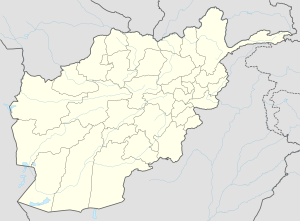Hajigak mining concession
| Hajigak Mine | |
|---|---|
| Hajigak Mine | |
| Coordinates: 34°40′N 67°57′E / 34.667°N 67.950°ECoordinates: 34°40′N 67°57′E / 34.667°N 67.950°E | |
| Country |
|
| Provinces | Bamyan and Maidan Wardak |
| Districts | Shibar and Hesa Awal Behsood |
| Elevation | 12,139 ft (3,700 m) |
Hajigak Mine is the best known and largest iron oxide deposit in Afghanistan, located near the Hajigak Pass, with its area divided between Bamyan and Maidan Wardak provinces. It has the biggest untapped iron ore deposits of Asia.
The deposit itself stretches over 32 km and contains 16 separate zones, up to 5 km in length, 380 m wide and extending 550 m down dip, seven of which have been studied in detail. The ore occurs in both primary and oxidized states. The primary ore accounts for 80% of the deposit and consists of magnetite, pyrite and minor chalcopyrite. The remaining 20% is oxidized and consists of three hematitic ore types. The deposit remained unmined in 2006. The presence of coking coal nearby at Shabashak in the Dar-l-Suf District and large iron ore resources made the deposit viable for future development of an Afghan steel industry. Open pit mining and blast furnace smelting operations were envisioned by an early feasibility study. The Hajigak also includes the unusual niobium, a soft metal used in the production of superconducting steel.
History reveals that Germans were the first one to exploit this deposit systematically after planning a steel mill during or after World War I. But the Great Game prevented this venture. Russians in the sixties prepared a comprehensive report on the mineral resources of Afghanistan and tried to exploit but they also failed.
When the Kala Bagh steel mill was planned in the late 1960s in Pakistan, it was thought to use some percentage of Hajigak iron ore as the Pakistani mines were not of good quality but this scheme also failed.
Afghanistan has a complex geology due to its position on the junction between the Indo-Pakistan and Asian crustal plates. It is composed of a series of terranes that broke away from the main Gondwana super-continent before becoming accreted onto the southern margin of the Eurasian plate. The accretionary events started in the Cretaceous, around 140 million years ago, and have continued until recent times. At some stage in the early Cretaceous there is evidence of a collision of one of these blocks, the Farad block, with the Eurasian plate, along the Herat fault zone. Shortly afterwards, the Helmand block collided with the Farad block. The rocks that host the Hajigak deposit are within the Herat fault zone, and it is likely they were originally part of the Farad and Helmand Blocks.
The oldest part of the succession crops out north-west of the Hajigak deposits. It consists of grey silicified limestones and dolomites interbedded with dark grey crystalline schists and light coloured quartzites that display evidence of amphibolite grade metamorphism. The Hajigak iron deposit is hosted by the Upper Proterozoic Awband Formation that, together with the underlying Kab Formation, constitutes the Qala Series, a sequence of metavolcanic and metasedimentary rocks up to 4500m thick. The Kab Formation consists of dark grey sandy sericitic schists, interpreted as metamorphosed terrigenous rocks, acid volcanic rocks and minor beds of marble and phyllite. The Awband Formation is made up of schists (quartz-sericite, quartzchlorite-sericite, quartz-sericitechlorite and carbonaceoussericite) that are metamorphosed acid and basic tuffites and argillaceous rocks. Minor cherts and marbles also occur. The Green Schist Formation, a distinctive unit overlying the Awband Formation, consists dominantly of green chlorite schists, and quartz-sericitic schists locally intruded by granodiorites. Some reports consider it as a member of the Awband Formation. Upper Devonian rocks of the Hajigak Formation are faulted against the Green Schist Formation. Strata of Lower Cretaceous and younger age crop out in the south west of the area, unconformable on the older sequences.
...
Wikipedia

